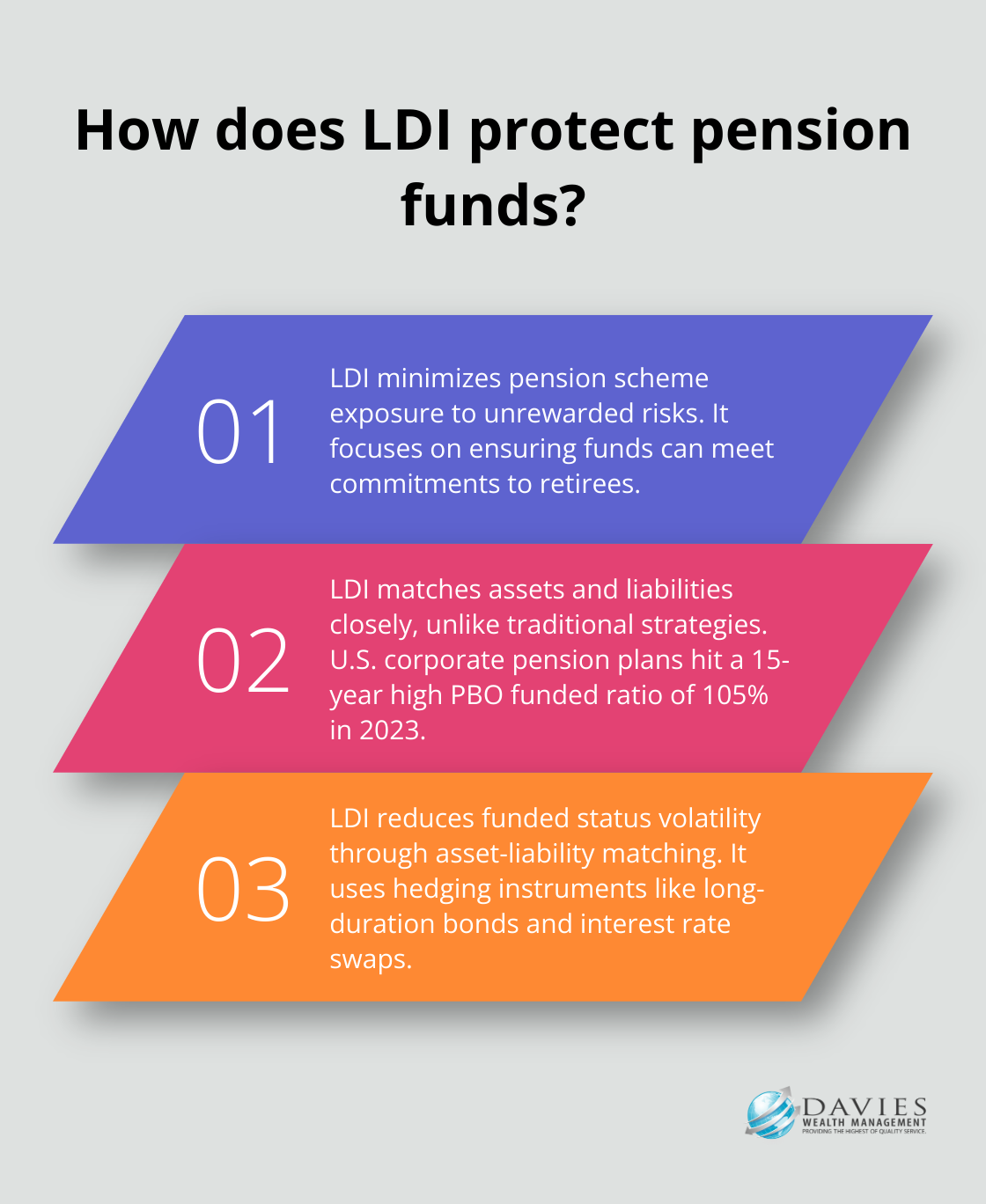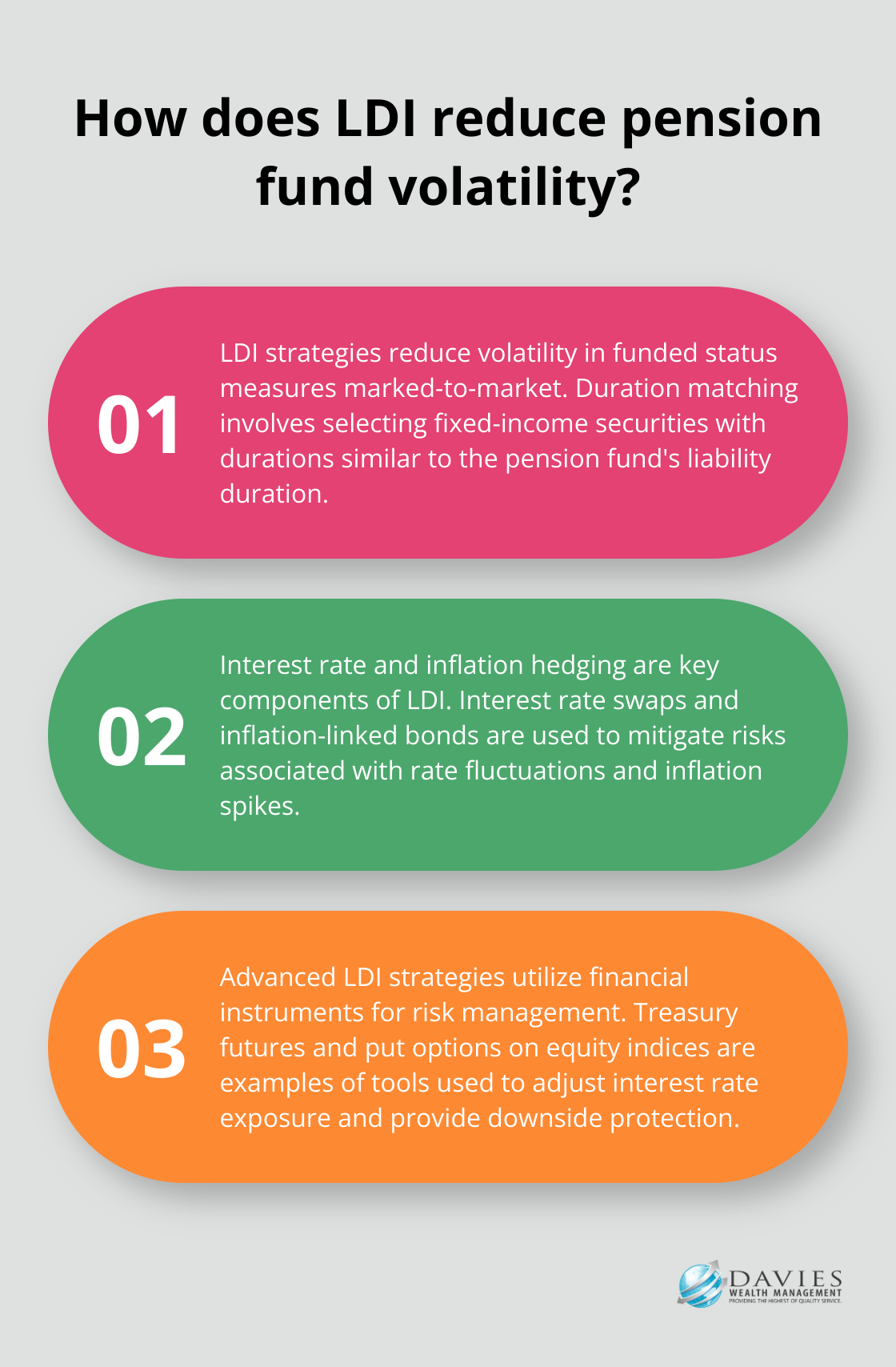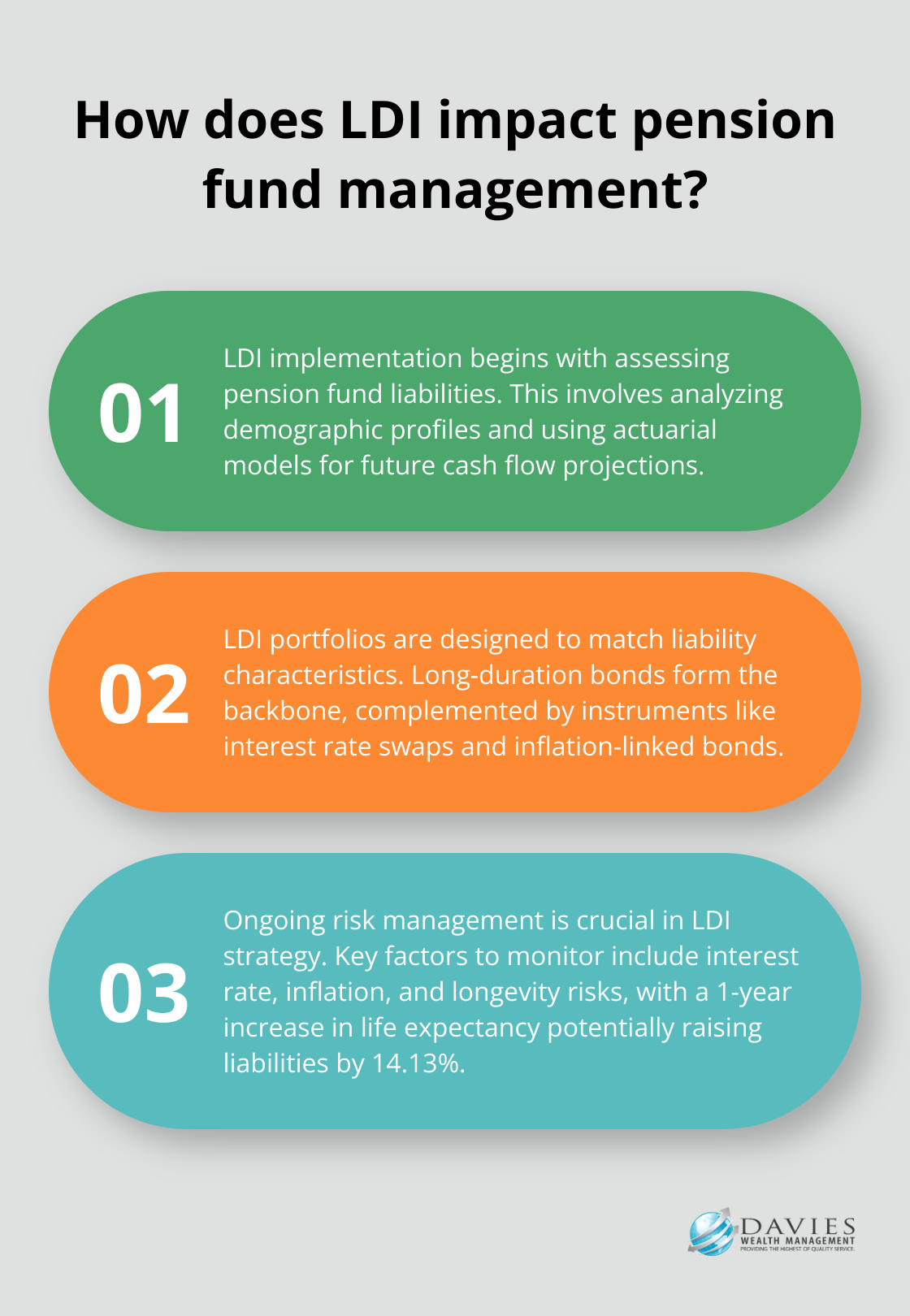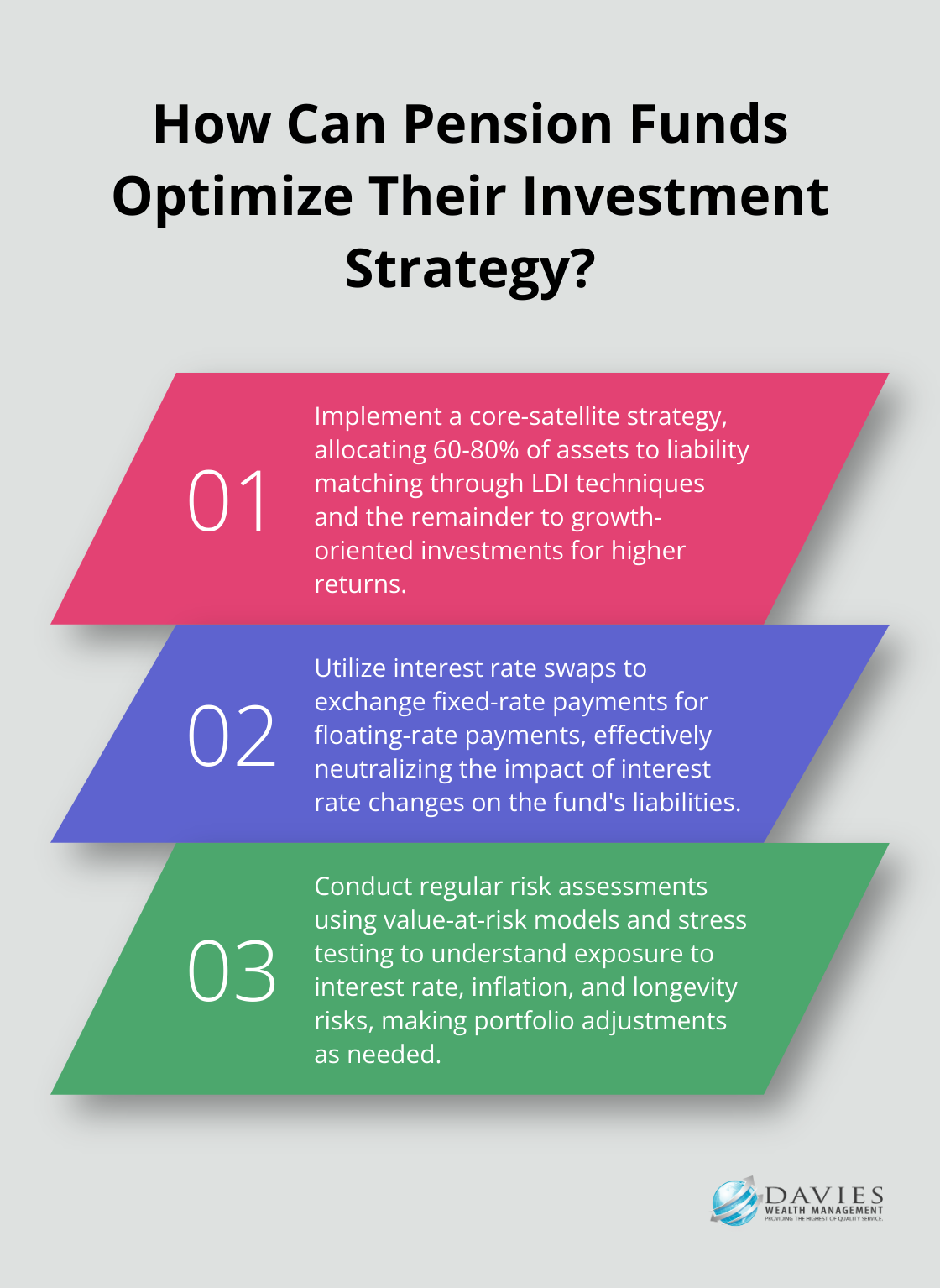Pension funds face unique challenges in managing long-term liabilities while seeking sustainable returns. At Davies Wealth Management, we recognize the critical role of Liability Driven Investment (LDI) strategies in addressing these complex needs.
LDI approaches offer pension funds a tailored solution to match assets with future obligations, mitigating risks and enhancing overall financial stability. This post explores the key components and implementation of liability driven investment strategies for pension funds, providing insights into this sophisticated investment framework.
Understanding Liability Driven Investment (LDI)
The Core of LDI
Liability Driven Investment products are designed to minimise a pension scheme’s exposure to unrewarded risks. LDI’s primary focus is to minimize the risk of a pension fund failing to meet its commitments to retirees.

LDI differs markedly from traditional investment strategies. While conventional approaches often prioritize return maximization, LDI adopts a more comprehensive view. It considers both the assets and liabilities of a pension fund, aiming to match them as closely as possible.
This approach holds particular relevance in the current economic climate. With interest rates at their highest levels in over a decade, pension funds face a unique opportunity to reassess their LDI strategies. The Projected Benefit Obligation (PBO) funded ratios of U.S. corporate pension plans hit a 15-year high of 105% in 2023, according to the BlackRock U.S. LDI.
Objectives of LDI Strategies
The main goal of LDI is to ensure a pension fund’s ability to meet future obligations, regardless of market fluctuations. This involves careful management of interest rate and inflation risks, which can significantly impact a fund’s ability to pay out pensions.
A key objective is to reduce the volatility of a pension fund’s funded status. Funds typically achieve this through a combination of asset-liability matching and the use of hedging instruments. For example, a pension fund might use long-duration bonds to match the duration of its liabilities, or employ interest rate swaps to hedge against rate fluctuations.
Effective LDI Implementation
Implementing an effective LDI strategy requires a deep understanding of a pension fund’s specific liability profile. This includes analyzing sensitivity to treasury rates and credit spread movements. Many financial advisors (including those at Davies Wealth Management) emphasize the importance of customized solutions that account for each fund’s unique circumstances.
Regular monitoring and adjustment of LDI strategies is essential. As market conditions change, so too should the approach. For instance, with current interest rates at historic highs, many pension funds are reassessing their target hedge ratios and curve exposures.
Balancing Risk and Growth
Effective LDI also involves balancing risk mitigation with the need for growth. While matching assets to liabilities is important, pension funds must also generate sufficient returns to remain sustainable in the long term. This often involves maintaining a diversified portfolio that includes both liability-matching assets and growth-oriented investments.
The next chapter will explore the specific components that make up an effective LDI strategy, including asset-liability matching, interest rate and inflation hedging, and the use of various financial instruments.
Building Blocks of Effective LDI
Asset-Liability Matching
Liability-driven investing (LDI) strategies can be effective at reducing volatility in funded status measures that are marked-to-market (MTM). This process requires a detailed analysis of a pension fund’s future obligations and the structuring of the investment portfolio to mirror these commitments.

Duration matching stands out as an effective approach. This technique involves the selection of fixed-income securities with durations similar to the pension fund’s liability duration. For instance, if a fund’s liabilities have an average duration of 12 years, the investment team will construct a bond portfolio with a comparable duration.
Interest Rate and Inflation Hedging
Interest rate fluctuations and inflation pose significant risks to pension funds. To mitigate these risks, LDI strategies often incorporate hedging techniques.
The use of interest rate swaps has gained popularity as a hedging method. These derivatives allow pension funds to exchange fixed-rate payments for floating-rate payments, effectively neutralizing the impact of interest rate changes on the fund’s liabilities. Similarly, inflation-linked bonds provide a hedge against unexpected inflation spikes.
Leveraging Financial Instruments
Advanced LDI strategies often utilize a range of financial instruments to fine-tune risk management. These may include futures contracts, options, and other derivatives.
Pension funds might use Treasury futures to adjust their interest rate exposure quickly and cost-effectively. Alternatively, put options on equity indices can provide downside protection for the growth portion of the portfolio.
Cashflow Matching and Immunization
The ability of a pension fund to meet its payment obligations is paramount. Cashflow matching involves the structuring of the investment portfolio to generate income that aligns with expected benefit payments. This approach holds particular importance for mature pension plans with a high proportion of retirees.
Immunization takes this concept further by attempting to make the portfolio value insensitive to interest rate changes.
The implementation of these components requires sophisticated modeling and ongoing monitoring. Advanced analytics tools continuously assess and adjust LDI strategies, ensuring they remain aligned with evolving market conditions and pension fund dynamics.
As we move forward, we will explore the practical aspects of implementing LDI strategies in pension fund management, including the assessment of liabilities and the design of appropriate portfolios.
Implementing LDI: A Practical Guide for Pension Funds
Assessing Pension Fund Liabilities
The implementation of an LDI strategy starts with a thorough assessment of the pension fund’s liabilities. This step requires a detailed analysis of the fund’s demographic profile, which includes the age distribution of members, expected retirement dates, and projected benefit payments.

Actuarial models play a key role in this process. These models project future cash flows based on various factors, including mortality rates, salary growth, and inflation expectations. Advanced stochastic modeling techniques (such as Monte Carlo simulations) provide a more nuanced understanding of potential liability outcomes under different scenarios.
Designing the LDI Portfolio
After an accurate assessment of liabilities, the next step involves the design of an appropriate LDI portfolio. This process requires the selection of a mix of assets that closely match the characteristics of the fund’s liabilities.
Long-duration bonds often form the backbone of an LDI portfolio. A well-designed LDI portfolio extends beyond simple bond allocation. It may include a range of instruments such as interest rate swaps, inflation-linked bonds, and certain types of alternative investments. For example, infrastructure investments can provide stable, inflation-linked cash flows that align well with pension liabilities.
Risk Management and Monitoring
The implementation of an LDI strategy requires ongoing risk management and monitoring. This process involves regular reassessment of both assets and liabilities, as well as portfolio adjustments as needed.
Key risk factors to monitor include interest rate risk, inflation risk, and longevity risk. An extra year of life expectancy at retirement can increase pension liabilities by 14.13 percent, which is significant and has long-term adverse effects. Sophisticated risk management tools (such as value-at-risk models and stress testing) help pension fund managers understand their exposure to these risks and make informed decisions.
Balancing LDI with Growth Assets
While LDI focuses on matching assets to liabilities, pension funds must also generate returns to remain sustainable. This need necessitates a careful balance between liability-matching assets and growth-oriented investments.
A common approach uses a core-satellite strategy. The core portfolio, typically comprising 60-80% of assets, focuses on liability matching through LDI techniques. The satellite portfolio, making up the remainder, seeks higher returns through a diversified mix of growth assets.
The optimal balance depends on various factors, including the fund’s funded status, risk tolerance, and regulatory environment. For instance, a well-funded pension plan might allocate a larger portion to growth assets, while an underfunded plan might need to prioritize liability matching.
Expertise and Tools
The implementation of an effective LDI strategy requires expertise, sophisticated tools, and ongoing commitment. While the process can be complex, the potential benefits in terms of improved funding stability and risk management make it a valuable approach for many pension funds.
Asset-liability modeling techniques are crucial in LDI. A liability-driven investment (LDI) is an investment in assets that can generate the cash to pay for financial obligations (liabilities).
Final Thoughts
Liability-driven investment strategies for pension funds offer significant benefits, including reduced funding volatility and improved risk management. These approaches enable pension funds to navigate complex market conditions while maintaining their ability to meet future commitments to retirees. However, the implementation of LDI strategies presents challenges, such as the need for specialized expertise and the balance between liability matching and growth objectives.

The future of LDI in pension management appears promising, with continued innovation expected as market conditions evolve and new financial instruments emerge. Advanced technologies may further enhance the precision and effectiveness of liability-driven strategies. This evolution will likely solidify the role of LDI strategies in ensuring the financial health and sustainability of pension funds.
Davies Wealth Management understands the intricacies of LDI strategies for pension funds. Our team of experienced professionals (with nearly a century of combined experience) assists pension funds in implementing effective LDI approaches that balance risk management with long-term growth objectives. We offer personalized wealth management services, including comprehensive financial advisory and investment management, tailored to each client’s unique goals and circumstances.



Leave a Reply